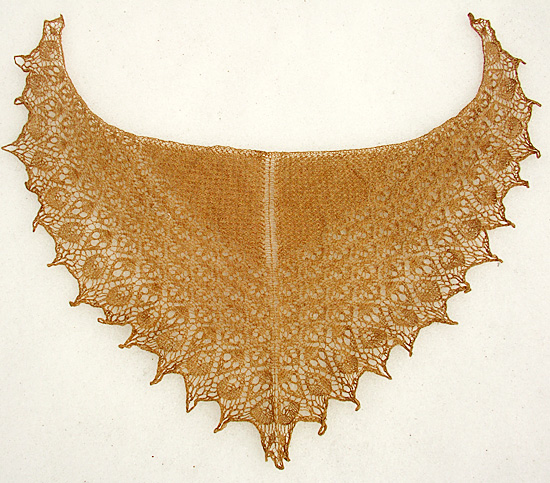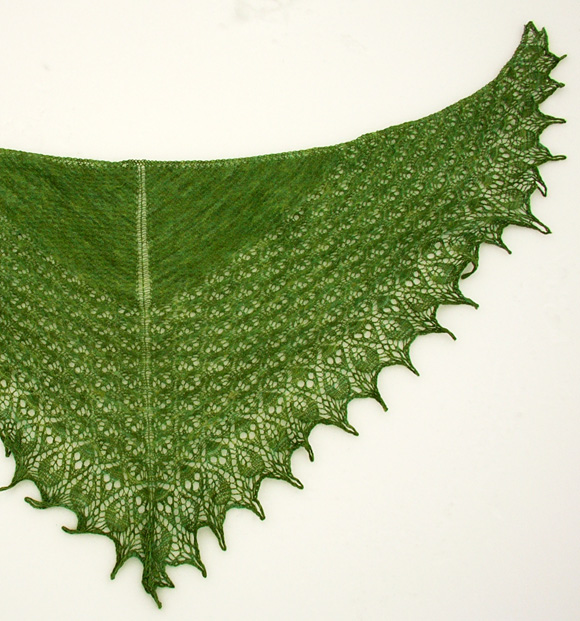This pattern
is modular.
As long as you finish each chart on row 8,
you can repeat the Star chart or the Blossom
chart as many times as you like before moving
on to the next chart. Just be aware that the
Edging section requires a surprising quantity
of yarn. For the green shawl, the final 28
rows and bind-off required 32% of the yarn.
For the smaller brown shoulderette, the edging
required 44% of the yarn!
If you are using stitch markers between each
pattern repeat to keep track of the lace pattern,
note that there will be points in each chart
where decreases within the pattern will necessitate
moving the markers. For example, in Row 4 of
the Blossom Chart, the [k2tog] at the end of
the repeat would be worked with the sts just
before and after the marker. Remove the marker
before working this decrease and replace it
afterwards, checking to be sure it is in the
correct position and that the repeat still
has the correct number of sts. Stitch markers
are not recommended for the Set-Up and Star
Charts.
Estonian Stitches:
This shawl was inspired by three stitch patterns
from Pitsilised Koekirjad, an Estonian
stitch dictionary. The stitches in this shawl
are based on several variants of star stitches.
For an excellent description of Estonian
lace stitches, see this
site.
For more examples of the beautiful stitches
originating in Estonia, take a look at the
Estonian
Lace Study.
Row 17 of the edging includes a 2-stitch mini
cable crossing. Accent cable crossings are
a common feature of Estonian lace patterns
in Pitsilised Koekirjad.
Crochet Cast-On
Using waste yarn, work a crochet chain several
sts longer than the number of sts to be cast
on. Starting 1 or 2 sts in from end of chain
and using working yarn, pick up and k 1 st
in the back loop of each ch until the required
number of sts have been picked up. Later,
the chain will be unraveled and the resulting
live sts picked up.
K3tog: Knit next 3 sts together.
Sssk: Slip next 3 sts knitwise, one at a time,
to right needle. Insert left needle into
fronts of these 3 sts and knit them together.
S2KP: Slip next 2 sts together, knitwise, as
if to work a k2tog. Knit next st through back
loop, then pass both slipped sts over st just
knit. This forms a centered double decrease.
SK2P: Slip 1 knitwise, k2tog, pass slipped
st over. 2 sts decreased.
RT (Right Twist): K into back of second st
on left needle, k into front of first st on
neft needle, drop both sts from left needle.
1-into-3 star: [K1 tbl, yo, k1 tbl] in next
st. 1 st increased to 3 sts.
3-into-3 star: K3tog without dropping sts from
left needle; yo, k same 3 sts together again
and drop from left needle. Number of sts has
not changed.
3-into-2 star: K3tog without dropping sts from
left needle, p same 3 sts together and drop
from left needle. 3 sts decreased to 2 sts.
3-into-9 star: K3tog without dropping sts from
left needle, yo, [k same 3 sts together again
without dropping from left needle, yo] 3 times,
k same 3 sts together again and drop from left
needle. 3 sts increased to 9 sts.
2-into-9 star: K2tog tbl without
dropping sts from left needle, yo, [k same
2 sts together again without dropping from
left needle, yo] 3 times, k same 2 sts together
again and drop from left needle. 2 sts increased
to 9 sts.
Directions for blocking a lace shawl may be
found here.


|

